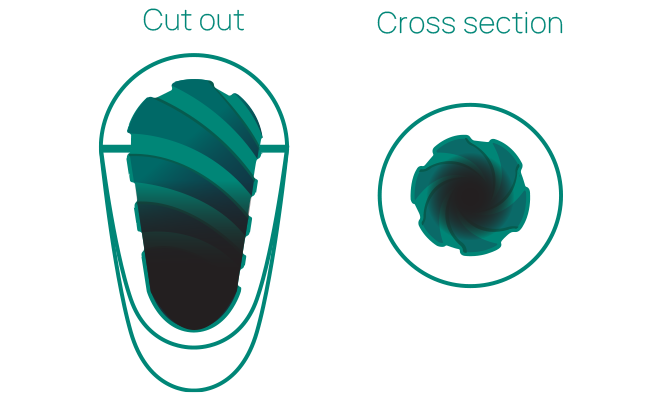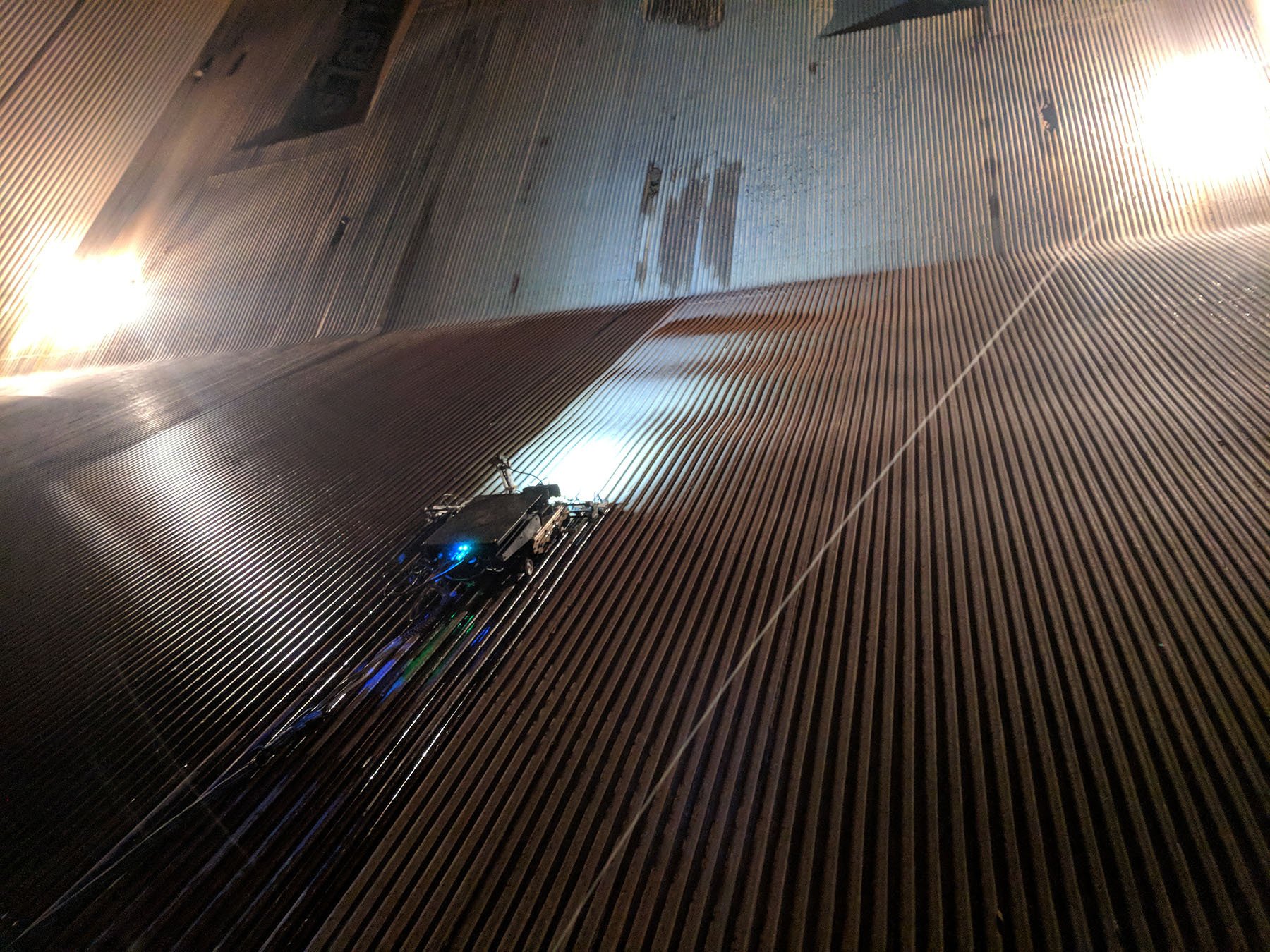In thermal power generation, there are a number of processes in place within the boiler to optimize the efficiency of thermal energy exchange, including tube design and configuration. Multi-lead rifle (MLR) tubes are specially fabricated to promote heat exchange by creating turbulence and increasing the surface area inside the tube. For boilers operating in high pressure and high temperature environments, this tube design is especially beneficial because it is able to withstand harsher conditions without failing. Despite the benefits, MLR tubes have a number of drawbacks related to their design and inspection efficacy. Fortunately, robot-based NDT methods, such as Rapid Ultrasonic Gridding (RUG) are equipped with specialized transducers to provide accurate thickness readings despite the internal design.
MLR Tube Benefits and Basics
In general, thermal power generation is accomplished by using high pressure and high temperature steam to spin a steam turbine. The rotation of the steam turbine drives a generator that produces electric power. Boilers play a critical role in this process by using thermal energy to convert water to steam inside their tubes. Boiler tubes are produced in a variety of sizes and configurations. Specifically, multi-lead rifle (MLR) tubes are used in heat exchangers and boilers to further increase the energy efficiency of heat transfer. They are internally ribbed in a helical pattern which generates centrifugal force to move steam bubbles to the middle of the tube and force the liquid water against the tube wall to promote cooling. Additionally, the ribs increase the internal surface area which also improves the heat transfer rate.

The furnace tubes of boilers are typically filled with a mixture of liquid water and steam vapor bubbles. Water has much greater thermal conductivity than steam. Keeping water against the tube walls is important for the safe operation of boilers because efficient heat transfer, or heat flux, keeps the tube walls from overheating. Critical Heat Flux (CHF) is a limit defined by the fluid pressure and ratio of liquid to vapor within the tube. Exceeding the CHF means there will be too much steam on the tube walls and heat cannot be removed. This overheated condition results in dry places on the tube wall and the eventual rupturing of the tube.
Because of the internal ribbing, MLR tubes increase the CHF limit by creating turbulence in the fluid flow that forces the liquid against the wall, cooling the walls, and increasing the amount of heat flux the tube can be absorbed before the tube wall is covered with too much vapor. This margin helps mitigate the upsets and imbalances in heat flux across the furnace wall and fluid flow through each tube. When compared to standard boiler tubes, MLR tubes can have a CHF twice as great, allowing the boiler to operate more safely and efficiently under higher pressure and temperature conditions.
MLR tubing is frequently found in boilers where it’s beneficial to increase the margin above CHF, such as drum boilers operating over 2,200 psi, supercritical boilers, sub-critical or sliding pressure once through boilers, cyclone furnaces, or recovery boiler floors where horizontal or sloping tubes are heated from above. Outside of these conditions, boiler owner/operators may opt for MLR tubing since the cost difference is marginal compared to standard tubing, but it isn’t essential for the asset’s efficient or safe operation.
Common Challenges of MLR Tubing
Despite the numerous benefits of MLR tubing for improving boiler operation and efficiency, the tubing’s unique design has a couple of drawbacks. One challenge is related to the potential machining of the ribs from the tube’s inner diameter (ID) at butt welds which may produce localized thinning of the tube wall and compromise its integrity. Sometimes, flow disturbances may occur at these discontinuities and attract internal deposits and associated issues.
From a boiler inspection standpoint, the ribs (peaks) and gaps (valleys) of the helical design present several challenges. It’s important to note that when inspecting MLR tubes, the thickness of the tube wall in the region between the ribs sets the minimum thickness. When inspecting for corrosion and other damage mechanisms, conventional ultrasonic testing (UT) often cannot differentiate between the signals reflected from the ribs versus the gaps. This signal confusion results in readings that overestimate the remaining thickness by accounting for the rib as well as the gap thickness. Additionally, tight or uneven rib spacing makes it difficult to get clear and accurate readings. Fortunately, robotic-enabled UT techniques have proven successful in providing accurate readings that can differentiate between the peak and valley thickness.
Immersion Transducers for Improved Inspection
Rapid Ultrasonic Gridding (RUG) is a robot-based inspection method with specialized narrow beam, immersion transducers that can reliably differentiate between rib and gap thicknesses. The robots use small diameter, high frequency cylindrically focused immersion transducers to reduce unnecessary amounts of beam spread. The signal is pulsed 25 times per second as the robot crawls along the boiler allowing it to easily resolve between the edges of the internal ribbing. Conversely, most conventional manual UT setups have 2-3 times the beam spread causing ribbing peak to valley transitions to "blend in" with one another. This makes the thickness difference difficult or even impossible to discern. Because of the transducer design and software pulsing, RUG provides accurate readings for thickness measurement and corrosion rate determination.

The benefits of RUG inspections for MLR tubing include:
- Narrow beam transducers for accurate thickness measurement
- Efficient inspections, covering almost 5,000 ft2 (465 m2) per shift
- Reduction in access requirements including scaffolding, ropes, and man lifts
- Impressive data density for full coverage corrosion mapping
In conclusion, MLR tubes often found and are extremely beneficial for use in boilers with operating conditions where CHF might be exceeded, including drum boilers operating above 2200 psi, supercritical boilers, sub-critical or sliding pressure once through boilers, cyclone boilers, and recovery boiler floors, because the internal ribbing promotes turbulence and increases surface area for efficient thermal heat exchange. While the ribbing presents challenges for conventional UT inspection, robot-based methods like RUG are equipped with specialized immersion transducers that can easily differentiate between the peaks and valleys of MLR tubes to provide accurate thickness readings.
